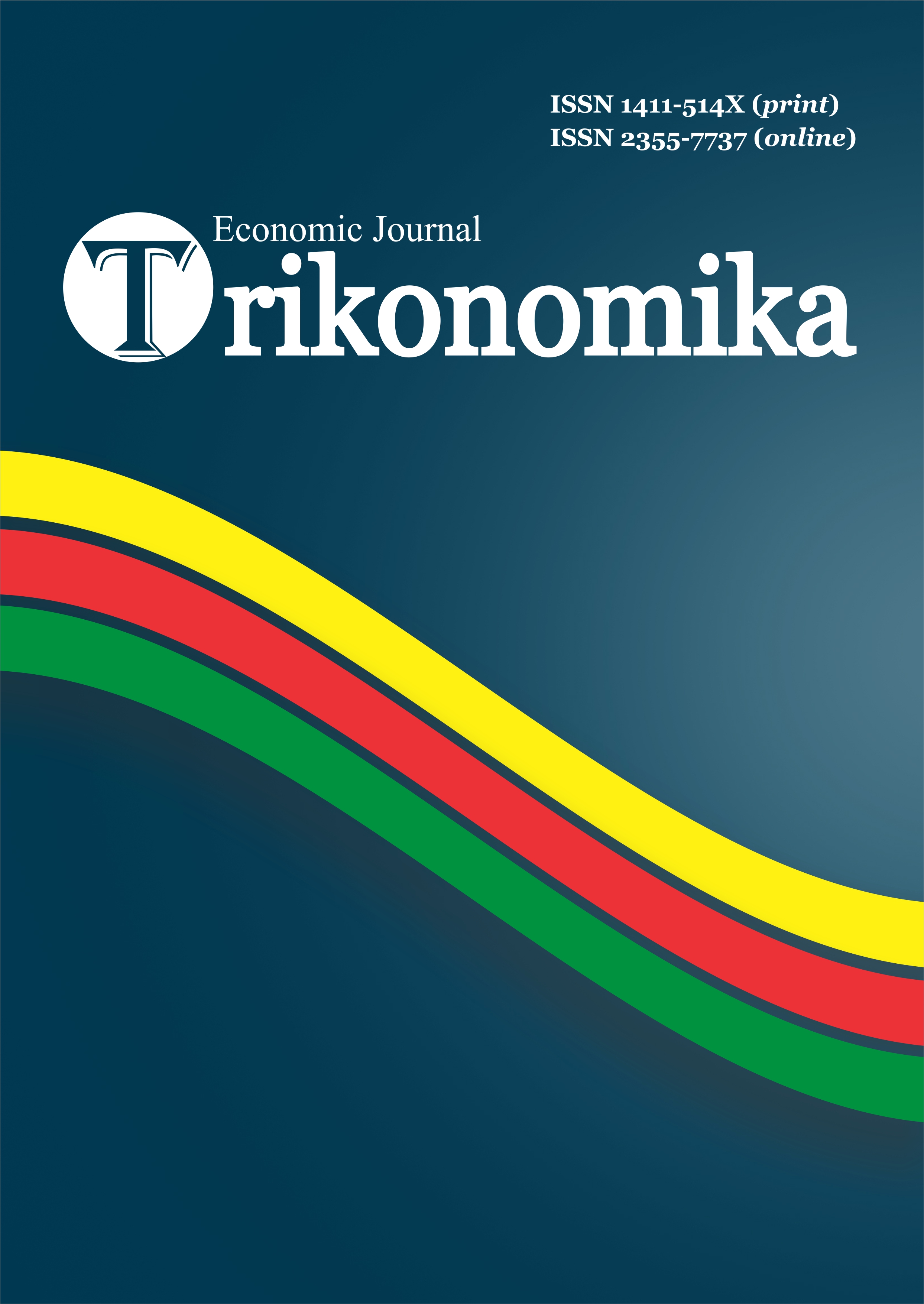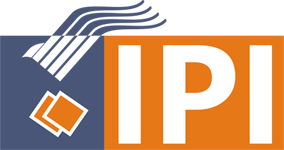COVID-19 HEALTHCARE WORKER BURNOUT: WORK ENVIRONMENT AND WORKLOAD AS INFLUENCING FACTORS
DOI:
https://doi.org/10.23969/trikonomika.v23i2.5352Keywords:
work environment, workload, burnout, health workerAbstract
The COVID-19 pandemic is an unexpected event. Hospitals must maintain the burnout level of health workers to maintain optimal energy in providing health services. One way to keep the burnout level of health workers in X Hospital is to pay attention to the work environment and workload. The non-probability sampling method used in this research is quantitative with descriptive research analysis. The analytical method used is multiple linear regression. The results showed that the work environment variables were not good, and workload and burnout were in a relatively high category. Results based on a coefficient of determination of 18.2% burnout in health workers caring for COVID-19 patients at Hospital X are influenced by the physical work environment and workload. This study concluded that the physical work environment and workload significantly affected the burnout of health workers treating COVID-19 patients at X Hospital.
Downloads
References
Amanullah, S., & Shankar, RR 2020. The Impact of COVID-19 on Doctor Burnout Globally: An Overview. Health (Basel), 8 (4), 421.
Algunmeeyn, A., El-Dahiyat, F., Altakhineh, M. 2020. Understanding the Factors Influencing Healthcare Providers' Burnout during the Outbreak of COVID-19 in Jordanian Hospitals. Journal of Pharmaceutical Policy and Practice, 13(1).
Astutik, Y. & Bawono, Y. 2024. Pengalaman Burnout pada Perawat di Masa Pandemi COVID-19: Sebuah Analisis Fenomenologi Interpretatif. Jurnal Kesehatan. Vol.11. No.2.
Bektas, C., & Peresadko, G. 2013. The Workplace Guidelines Framework for Coping with Fatigue Syndrome: A Model Suggestion. Procedia - Social and Behavioral Sciences, 84, 879–884. https://doi.org/10.1016/j.sbspro.2013.06.666
Burhan, E., Susanto, A. D., Nasution, S. A., Ginanjar, E., Pitoyo, C. W., Susilo, A., & Sambo, M. 2020. Pedoman Tatalaksana COVID-19 edisi 4. Jakarta: PDPI, PERKI, PAPDI, PERDATIN, IDAI, 2 (1).
Cai, H., Ty, B., Ma, J., Chen, L., Fu, L., Jiang, Y., & Zhuang, Q. 2020. Psychological Impact and Coping Strategies of Frontline Medical Staff in Hunan Between January and March 2020 During the Outbreak of Coronavirus Disease 2019 (COVID-19) in Hubei, China. Medical Science Monitor: International Medical Journal of Experimental and Clinical Research, 26, https://doi.org/10.12659/MSM.924171
Cinar, D., Akça, NK, Bahçeli, PZ, & Bağ, Y. 2021. Perceived Stress and Influencing Factors Related to the COVID-19 Pandemic of Emergency Nurses in Turkey. Journal of Nursing Management, 29 (7), 1916–1923. https://doi.org/10.1111/jonm.13329
Cubitt, LJ, Im, YR, Scott, CJ, Jeynes, LC, & Molyneux, PD. 2021. Beyond PPE: A Mixed Qualitative-Quantitative Study Captures the Broader Issues Affecting Physician Well-Being during the COVID-19 Pandemic. BMJ Open, 11 (3), 1–8. https://doi.org/10.1136/bmjopen-2021-050223
Dessler, G. 2015. Human Resource Management (14th ed.). Pearson Education Limited.
Dimitriu, MCT, Pantea-Stoian, A., Smaranda, AC, Nica, AA, Carap, AC, Constantin, VD, Davitoiu, AM, Cirstoveanu, C., Bacalbasa, N., Bratu, OG, Jacota-Alexe, F ., Badiu, CD, Smarandache, CG, & Socea, B. 2020. Burnout Syndrome in the Romanian Medical Population At The Time of the COVID-19 Pandemic. The Medical Hypothesis, 144 (109972), 1-4. https://doi.org/10.1016/j.mehy.2020.109972
Fajri, N., Sasmita, J., & Fitri, K. 2017. Pengaruh Kedisiplinan, Motivasi dan Lingkungan Kerja Fisik terhadap Kinerja Perawat Rumah Sakit Petala Bumi Pekanbaru. Jurnal Online Mahasiswa Fakultas Ekonomi, 4 (1).
Galanis, P., Vraka, I., Fragkou, D., Bilali, A., & Kaitelidou, D. 2021. Nurse Burnout and Associated Risk Factors during the COVID-19 Pandemic: A Systematic Review and Meta-analysis. Journal of Advanced Nursing, 77 (8), 3286–3302.
Gaye, YE, Agbajogu, C., & Oakley, R. El. 2021. COVID-19 In The Nile: An Overview of the Management and Outcomes of the COVID-19 Pandemic in the Arab Republic of Egypt from February to August 2020. International Journal of Environmental Research and Public Health, 18 (4), 1–10. https://doi.org/10.3390/ijerph18041588
Gibson, JL, Ivancevich, JM, James H. Donnelly, J., & Konopaske, R. 2012. Structures and Processes of Organizational Behavior (14th Edition). McGraw-Hill.
Greenberg, J., & Baron, RA 2008. Behavior in Organizations (9th ed.). Pearsons.
Karacic, J., Bursztajn, HJ, & Arvanitakis, M. 2021. Who Cares What Doctors Feel: Health's Political Responsibility for Boredom during a Pandemic. Health Care (Switzerland), 9 (11), 1-5. https://doi.org/10.3390/healthcare9111550
Launer, J. 2020. Fatigue in the era of COVID-19. Journal of Postgraduate Medicine, 96 (1136), 367–368. https://doi.org/10.1136/postgradmedj-2020-137980
Leiter, MP, & Maslach, C. 2017. Fatigue And Engagement: Contribution to the New Version. Saturation Research, 5, 55–57.
Liu, Q., Luo, D., Haase, JE, Guo, Q., Wang, XQ, Liu, S., Xia, L., Liu, Z., Yang, J., & Yang, BX. 2020. Experience of Healthcare Providers during The COVID-19 Crisis in China: A Qualitative Study. Lancet Global Health, 8 (6), e790–e798. https://doi.org/10.1016/S2214-109X(20)30204-7
Maqbali, M.Al, Sinani, M.Al, & Al-Lenjawi, B. 2021. Prevalence of Stress, Depression, Anxiety And Sleep Disturbances among Nurses during the COVID-19 Pandemic: A Systematic Review and Meta-Analysis. Journal of Psychosomatic Research, 141 (110343), 1–18.
Maslach, C., & Jackson, SE 2001. Experienced Burnout Measurement. Journal of Work Behavior, 2, 99-113.
McShane, SL, & Glinow, MA Von. 2018. Organizational Behavior: Emergence, Knowledge, Global Realities (8th ed.). McGraw-Hill Education.
Naz. 2016. Burnout and Quality of Life of Nurses in Tertiary Care Hospitals in Pakistan. Pulmed. Gov, 66 (6), 532–536.
Pradana, BA, Kristanto, RS, & DS, H. 2017. Pengaruh Lingkungan Kerja dan Beban Kerja terhadap Burnout pada Perawat RSUD Kardinah Kota Tegal. Magisma: Jurnal Ilmiah Ekonomi dan Bisnis, 5 (2).
Prasetya, A., Khairunnisa, H., & Aziz, AL 2021. Effect of Job Stress and Burnout on Job Satisfaction and Employee Performance. Proceedings of the 3rd Annual International Conference on Public and Business Administration (AICoBPA 2020), 191, 74–79.
Pratama, H. A. 2019. Pengaruh Lingkungan Kerja Fisik dan Non Fisik terhadap Kebosanan Kerja Karyawan di Akademi Maritim Yogyakarta (AMY). Majalah Ilmiah Bahari Jogja,17 (2), 73–83.
Restauri, N., & Sheridan, A. D. 2020. Burnout and Posttraumatic Stress Disorder in the Coronavirus Disease 2019 (COVID-19) Pandemic: Intersection, Impact, and Interventions. Journal of the American College of Radiology: JACR,17(7), https://doi.org/10.1016/j.jacr.2020.05.021
Robbins, S., & Judge, T. 2015. Perilaku Organisasi (16th Edition). Translated by Saraswati, Ratna. Salemba Empat.
Robbins, SP, & Coulter, M. 2010. Manajemen (10th ed.). Translated by Sabran, Bob, Putera, Devri Barnadi. Erlangga.
Ruetzler, K., Szarpak, L., Filipiak, KJ, Ladny, JR, & Sthey, J. 2020. The COVID-19 Pandemic — A View Of The Current State of the Problem. Journal of Disaster and Emergency Medicine, 5 (2), 106–107. https://doi.org/10.1136/bmj.m606
Sari, EP, & Johansyah. 2020. Pengaruh Beban Kerja dan Lingkungan Kerja Non-Fisik terhadap Burnout Karyawan pada PT. Wom Finance di Tenggarong. Jurnal Ekonomi dan Manajemen Indonesia, 2 (2), 102–113.
Satyawati, C.R. 2022. Burnout pada Tenaga Kesehatan selama Masa Pandemi. Self-efficacy Memiliki Pengaruh? Psikoborneo: Jurnal Ilmiah Psikologi. Scientific Journal of Psychology. Vol. 10 No. 4
Sedarmayanti. 2013. Manajemen Sumber Daya Manusia. Aditama Refika.
Smith, G., & Segal, J. 2008. Stress: Preventing Fatigue. China-Consult.Com.Au. http://www.china-consult.com.au/2009/11/20/3240/
Sønderskov, KM, Dinesen, PT, Santini, ZI, & Stergaard, SD. 2020. Danish Country Depression During The COVID-19 Pandemic. Acta Neuropsychiatrica, 32 (4), 226-228. https://doi.org/10.1017/neu.2020.15
Sun, D., Yang, D., Li, Y., Zhou, J., Wang, W., Wang, Q., Lin, N., Cao, A., Wang, H., & Zhang, Q. 2020. Psychological Impact of 2019 Novel Coronavirus (2019-nCoV) Outbreak on Health Workers in China. Epidemiology and Infection, 148, e96. https://doi.org/10.1017/S0950268820001090
Tarwaka. 2014. Ergonomi Industri: Dasar-Dasar Pengetahuan Ergonomi dan Aplikasi di Tempat Kerja (Revisi Edisi II). Surakarta: Harapan Press Solo.
Theorell, T. 2020. COVID-19 and Working Conditions in Health Services. Psychologist Psychologist, 89 (4), 193-194.
Vanchapo, AR. 2020. Workload and Work Stress (1st ed.). Publisher Qiara Media.
Yıldırım, M., & Solmaz, F. 2020. COVID-19 Saturation, COVID-19 Stress And Resilience: Preliminary Psychometric Properties of the COVID-19 Fatigue Scale. Death Studies, 46 (3), 524–532.
Zerbini, G., Ebigbo, A., Reicherts, P., Kunz, M., & Messman, H. 2020. Psychosocial Burden of Healthcare Professionals in Time of COVID-19 – a Survey Conducted at the University Hospital Augsburg. German Medical Science, GMS e-journal, 18(5), https://doi.org/10.3205/000281
Downloads
Published
How to Cite
Issue
Section
License
Copyright (c) 2024 TRIKONOMIKA: Jurnal Ekonomi

This work is licensed under a Creative Commons Attribution-NonCommercial-ShareAlike 4.0 International License.











